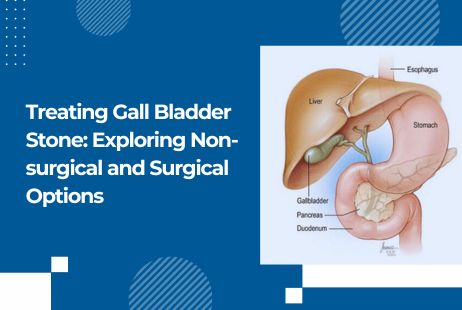
Are you experiencing persistent abdominal pain and discomfort? It could be a gall bladder stone causing all the trouble!
Read on as we shed light on what a gall bladder stone is and both non-surgical and surgical options for treating gall bladder stones.
What is a gall bladder stone?
The gallbladder is a small-sized, pear-shaped organ located beneath the liver. It plays a pivotal role in digestion by storing and releasing bile – a substance produced by the liver to aid in breaking down fats. However, this delicate balance can sometimes be disrupted when tiny particles called gallstones form within the gallbladder.
A gall bladder stone is a solid deposit that varies in size and composition. A gall bladder stone can range from as small as sand grain to as large as a golf ball. These stones usually comprise cholesterol or bilirubin – waste products that the liver should have processed and excreted through bile.
When these stones become too big or numerous, they may cause blockages in the bile ducts, leading to painful symptoms such as intense abdominal pain (particularly after eating fatty foods), nausea, vomiting, and jaundice (yellowing skin). In some cases, gallstones can even lead to severe complications like inflammation of the gallbladder or pancreas.
Non-surgical options for treating gall bladder stones
Non-surgical approaches to address gall bladder stones provide less invasive alternatives for patients seeking to avoid surgical procedures or those who may not be surgical candidates. Here are some effective non-surgical options:
Medication
Ursodeoxycholic acid is a medication that can gradually dissolve smaller gallstones over time, avoiding the need for surgery with consistent use.
Benefits:
- Avoids surgery, offering a non-invasive alternative.
- May gradually dissolve certain types of gallstones over time.
Risks:
- Not effective for all gallstone types.
- Requires patience, as results may take months or years to manifest.
Endoscopic Retrograde Cholangiopancreatography (ERCP) with Sphincterotomy
ERCP, combined with sphincterotomy, allows for removing or dissolving gallstones from the bile ducts without surgical incisions.
Benefits:
- Effective removal of gall bladder stones relieves pain and reduces the risk of complications such as inflammation or infection.
- A less invasive alternative to open surgery, resulting in shorter recovery times and reduced hospital stays.
Risks:
- A potential complication is where the pancreas becomes inflamed after the procedure, although the risk is relatively low.
- Like any medical procedure, there is a small risk of bleeding or infection associated with ERCP and sphincterotomy.
However, it’s essential to consult a professional with gall bladder stone treatment expertise to determine the most appropriate approach for your unique circumstances. Individual factors and the type of gallstone may influence the choice of treatment.
Options for Gall Bladder Stone Surgery
Gall bladder stone surgery becomes necessary when non-surgical methods prove ineffective or complications arise. Here are the primary surgical options:
Laparoscopic Cholecystectomy
In this minimally invasive gall bladder stone surgery, small abdominal incisions are made to remove the entire gall bladder using specialized instruments. It offers benefits like shorter recovery time, reduced pain, and smaller scars compared to open surgery.
Benefits:
- Offers immediate removal of gall bladder stones.
- Minimally invasive with smaller abdominal incisions.
- Generally shorter recovery time compared to open surgery.
Risks:
- Gall bladder stone surgery may carry a risk of infection.
- Potential injury to nearby organs.
Open Cholecystectomy
An open cholecystectomy may be required in cases of extensive inflammation or scarring. This involves a larger abdominal incision for gall bladder removal and is more invasive.
Benefits:
- Effective in cases of extensive inflammation or scarring.
Risks:
- More invasive with larger abdominal incisions.
- Longer recovery period compared to the laparoscopic approach.
Endoscopic Retrograde Cholangiopancreatography (ERCP)
Combining endoscopy with X-ray imaging, ERCP can locate and remove gallstones from the bile ducts, especially when stones have migrated beyond the gall bladder.
Benefits:
- Can locate and remove gallstones from the bile ducts.
Risks:
- Potential complications associated with endoscopy and X-ray imaging.
- Effectiveness varies depending on the location of the stones.
Consult Dr. Girish Juneja for Gall bladder stone removal surgery
If you seek expert care and guidance for removing gall bladder stones, consult Dr. Girish Juneja.
Dr. Juneja is a highly respected and experienced specialist in gastroenterology and minimally invasive procedures.
With expertise of 3 decades and a holistic approach to patient care, he can provide you with the best treatment options tailored to your needs.
Don’t delay addressing this health concern; take the first step by booking an appointment today.
